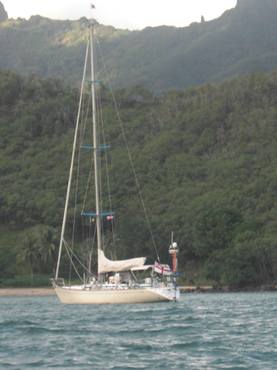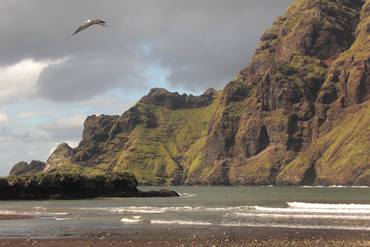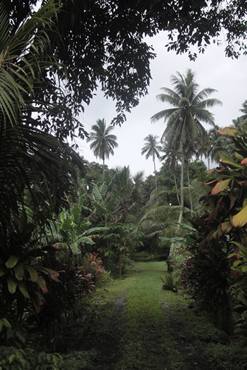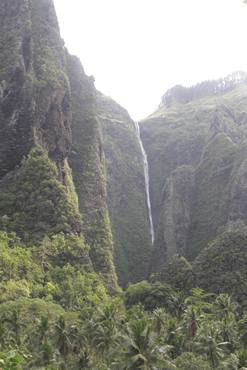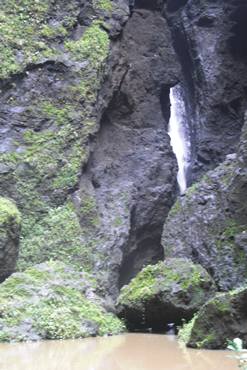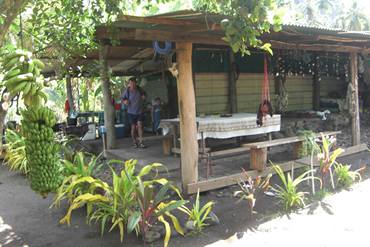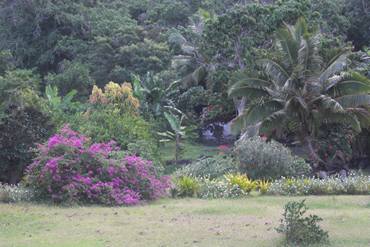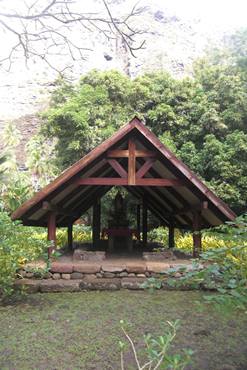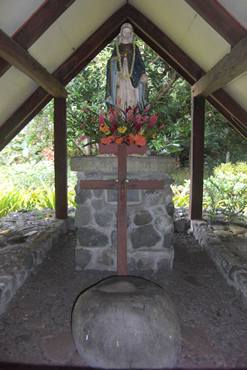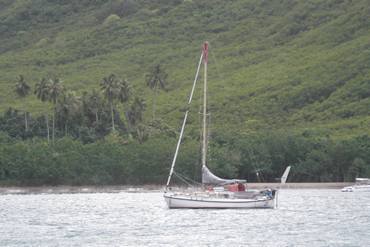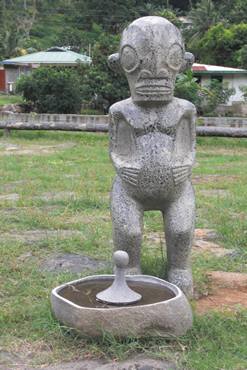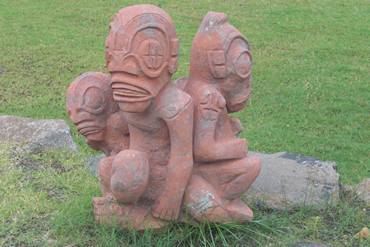Friday 13th July - Hiking in Hakaui

|
8:56.67S 140:09.84W Friday 13th July – Hiking in Hakaui Wednesday, 11th July saw us leave Our next anchorage was only about 5 miles away; whilst
Taiohae was peaceful,
Arnamentia in The other reason for coming to Hakatea Bay, or Daniel’s Bay as it is sometimes known, though he died a good few years ago now, was to walk up the Hakaui valley to the bottom of the Vaipo waterfall – reputedly the third tallest in the world at 800 metres. Early on Thursday morning, we donned our hiking trainers and set off. Landing, and later launching, the dinghy was a little exciting – the waves were breaking just a little too ferociously. Then it was time to carry the dinghy thirty yards or so up the beach as we’d landed at half tide. The Zodiac and Mercury engine are quite a bit heavier than the old Avon and Mariner – so that took a little time and a lot of puffing.
The dinghy landing spot The walk was about four or five miles in each direction and not challenging at all, apart from a couple of the half dozen or so river crossings required. It has rained a great deal recently so the river is in full spate but there were enough rocks to use as hand holds whilst crossing it and we managed with only a few slips and no total immersions. The track was laid several centuries ago when the valley was home to a number of settlements. But whilst the population of the Marquesas as a whole was estimated at the beginning of the nineteenth century at over 60,000, it had fallen to around 10,000 by the end of the twentieth century largely as an indirect result (disease, alcohol and tribal warfare) of the arrival of European seafarers of one sort or another. So, not much remains of the original settlements. Nonetheless, a walk along the track reveals, within the dense forest, remains of what were once substantial and substantially built dry stone buildings, outhouses and enclosures now all overgrown.
First section of the track The majority of waterfall could be seen from about three quarters the way along the track. However, its base is at the end of a canyon, obscured by over hanging cliffs and rocks so one can never see it in its entirety. We had to swim across a pool and scramble around the rocks to actually see the base – a very refreshing experience. Standing in the natural amphitheatre leading up to the waterfall is an awe-inspiring experience and one to which no amount of camera work could do justice – so we haven’t tried.
First sighting of the Vaipo waterfall Base of the waterfall and pool where we swam These days the lower reaches of the Hakaui valley are scattered with a few smallholdings where bananas, papaya, mangoes, pamplemousse and limes are grown. The somewhat makeshift houses are surrounded by a riot of gloriously coloured shrubs, bougainvillea and hibiscus. In one of the houses (the one next to the most incongruously placed telephone box we’ve ever seen) we had arranged to have lunch on our return from our walk. We were expecting something simple – a piece of chicken probably, but were stunned to be presented with crevettes, caught that morning in the river, cooked in coconut milk, plantain, savoury banana fritters, papaya, tomato and cucumber salad with vinaigrette, and coconut bread steamed in vine leaves, all washed down with home made lime squash. It was absolutely delicious and one of the best meals we’ve had ashore. We were also able to buy fruit, freshly picked off the trees, which should see us through to our first atoll in the Tuamotos.
Lunch stop
A gorgeous garden Also in the hamlet is a tiny chapel, with a table cloth covered altar and a large stone as a font. Very simple, but obviously well cared for and used. On the altar is a small plastic food storage tub containing donations left by visitors. It was apparent as we made our contribution that many have been pretty generous. Naturally there is absolutely no danger of any of the locals rifling it. The consequences would probably involve a complete bypassing of Purgatory en route for a hotter reception elsewhere.
Hakaui Chapel That evening we invited a young Swedish couple, Henrik
and Kiki, on board for drinks. They
are quite a remarkable pair; they too are sailing around the world, but in 28’
canoe-sterned (or, double-ended, depending upon your terminological preference)
sloop called Birka. And, being
canoe-sterned it is, internally, a very small 28 footer indeed. Instrumentation? Well, they’ve got an iPad with GPS, an
electronic speed log that doesn’t work and that’s it. Electronic echo-sounder? Pah! They have a large rusty padlock
connected to a length of string knotted at one metre intervals. Henrik observes that it doesn’t work
terribly well unless the boat is at a standstill – the padlock not being lead
and therefore not sinking quite as readily as it would if it were. But, hey, you get used to it. Shades of Slocum’s second-hand tin clock
which worked well enough for his sun sights once he’d boiled it, even though it
was missing its minute hand. Shades
also of Miles Smeeton, when informed by an aspiring ocean sailor about the sort
of electronics with which he thought he’d equip his boat, throwing open his
bedroom door, indicating the clockwork radio by his bedside and saying “That’s
the only electronic navigation aid we had on Tzu Hang for 18 years”! Shame on you, Arnamentia! Henrik and Kiki say they catch fish
almost daily on passage and survive well enough on that. They did a spell as skipper and galley
slave on a large charter catamaran based in
S/V Birka Tomorrow we will set sail for the Tuamotos. We could have left today but didn’t want to tempt fate on Friday, 13th! P.S. Omitted from the last blog were the photos of some of the tikis in and around Taiohae; they are mainly modern reproductions but nonetheless are quite remarkable. Some could well be models for the next aliens to bother Doctor Who.
|
